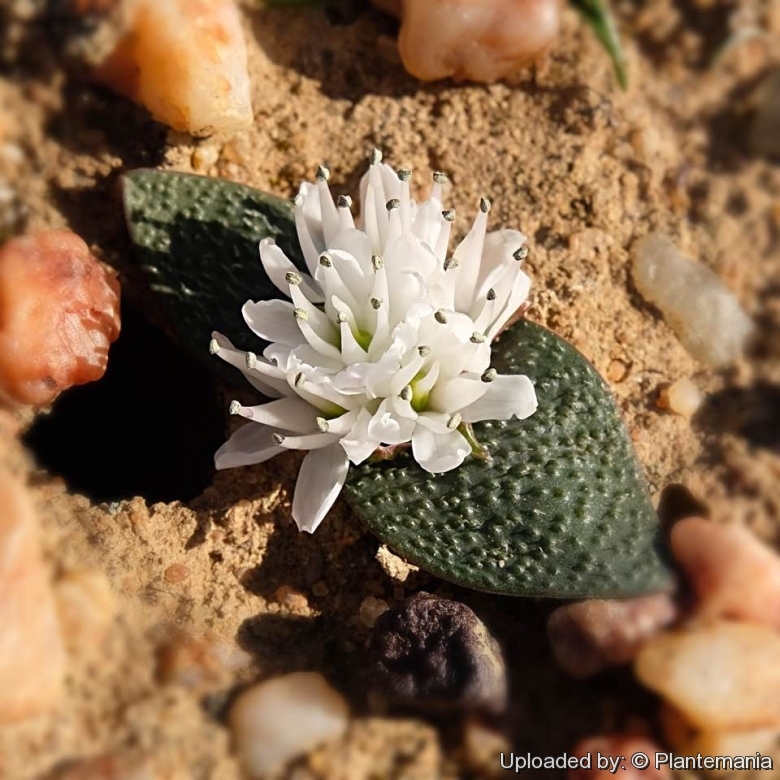
Massonia pygmaea Photo by: © Plantemania
This is a little miniature Massonia with short tufts of white flowers between pustulate or papilate leaves that usually only up to 30 mm long. It is adorably large flowered by comparison.
Origin and Habitat: Massonia pygmaeaSN|34285]]SN|34285]] is endemic to South Africa, occuring mostly in the Northern to Western Cape regions of South Africa.
Altitude range: This species often grows at high altitudes.
Synonyms:
See all synonyms of Massonia pygmaea
Description: Massonia pygmaea Kunth is a member of the Asparagaceae (formally Hyacinthaceae) and was previously known as Neobakeria heterandraSN|34287]]SN|34287]] and Polyxena bakeriSN|34289]]SN|34289]]. Each bulb produces a pair of unusual warty leaves with a spattering of long hairs. The central cluster of small flowers with conspicuous white or pink filaments topped by brown anthers, en masse, combine to give a most striking 'shaving-brush' effec. Apart from Massonia jasminifloraSN|33408]]SN|33408]], it is the smallest of the named Massonia species, individual leaves rarely attaining more than 6cm in length.
Bulb: Ovoid-subglobose.
Leaves: 2, prostrate, usually only up to 30 mm long, rarely attaining more than 6 cm in length, elliptical, obtuse, pustulate or papilate, coriaceous but somewhat fleshy.
Inflorescence: Politary at the centre between the two leaves. Peduncle short, slender; corymb dense, many-flowered. Pedicels as long as the flowers; bracts long, linear, membranous, dilated at the tip.
Flowers: Perianth-tube slender, elongated. Segments linear, thin, reflexed but little shorter than the tube. Stamens slightly biseriate. Filaments distinct, white or pink topped by brown anthers, the three upper slightly exceeding the perianth-segments.
Subspecies, varieties, forms and cultivars of plants belonging to the Massonia pygmaea group
Bibliography: Major references and further lectures
1) J. G. Baker “Flora Capensis”, page 253, 1897
2) Quarterly Bulletin of the Alpine Garden Society, Volumes 70-71, Alpine Garden Society (Great Britain), 2002
3) Pacific Bulb Society “Massonia” Accessed on 26-07-2017 from http://pacificbulbsociety.org/pbswiki/index.php/Massonia
4) Foden, W. & Potter, L. 2005. Massonia pygmaea Kunth subsp. pygmaea. National Assessment: Red List of South African Plants version 2017.1. Accessed on 2017/07/26
5) The Alpine Garden Society “Massonia pygmaea - plant of the month December 2016” Accessed on 26-07-2017 from http://www.alpinegardensociety.net/plants/plant-portraits/Massonia+pygmaea+plant+of+the+month+December+/120/
Cultivation and Propagation: Massonia pygmaeaSN|34285]]SN|34285]] is is usually the first of the Massonias to flower, the blooms appearing in early spring.
Soil: This species is best grown in pots, in sandy free draining potting mixture.
Exposure: Full sun.
Waterings: Dry off completely during summer dormancy.
Hardiness:* Some protection from extreme cold weather is necessary.
Propagation: Bulbs do eventually divide and propogation is fairly straight forward from seed.











